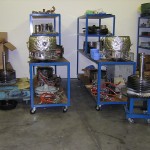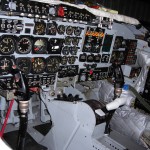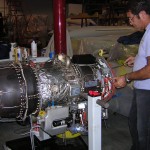The restoration begins
 921, after being abandoned for over 30 years, acquired an assortment of dings, dents, stolen equipment, and other assorted insults. But it was complete, airframe wise, and with its old engines in place. It was boxed up a second time and sent via ship to the US and its new home to be refurbished, restored, rebuilt, to new standards.
921, after being abandoned for over 30 years, acquired an assortment of dings, dents, stolen equipment, and other assorted insults. But it was complete, airframe wise, and with its old engines in place. It was boxed up a second time and sent via ship to the US and its new home to be refurbished, restored, rebuilt, to new standards.
 Every system, component, hose, hardware, cylinder, seal, was removed and made new again. Every hydraulic cylinder was found to be corroded beyond airworthiness, so new ones were fabricated, including shafts, wipers, O rings. Metal sheeting was replaced on the fuselage and tail where damage had occured. All controls, originally magnesium, were replaced with aluminum, then painted and re-balanced.
Every system, component, hose, hardware, cylinder, seal, was removed and made new again. Every hydraulic cylinder was found to be corroded beyond airworthiness, so new ones were fabricated, including shafts, wipers, O rings. Metal sheeting was replaced on the fuselage and tail where damage had occured. All controls, originally magnesium, were replaced with aluminum, then painted and re-balanced.
 The panel was kept as original as possible, all instruments overhauled. All wiring was either replaced, removed, or re-tested to ensure proper functionality. The explosive devises in the aircraft, the ejection seat charges and the canopy explosive shell, were removed for safety purposes. The jettison capability for its armament was removed and all underwing pylons were made to be fixed in place once attached. External fuel tanks can be removed by conventional means by putting a holding cradle underneath the tank and activating the internal manual release lever in the pylon.
The panel was kept as original as possible, all instruments overhauled. All wiring was either replaced, removed, or re-tested to ensure proper functionality. The explosive devises in the aircraft, the ejection seat charges and the canopy explosive shell, were removed for safety purposes. The jettison capability for its armament was removed and all underwing pylons were made to be fixed in place once attached. External fuel tanks can be removed by conventional means by putting a holding cradle underneath the tank and activating the internal manual release lever in the pylon.
 The engines were replaced with two new overhauled J85-17A engines, zero timed, with all new or overhauled accessories. Capable of 2,850 pounds of static thrust each–5,700 lbs total, the A37B has no problem pushing an empty weight of 5,572 lbs. The starters were overhauled and have proven to be more than capable of spinning up the little General Electric fuel burners.
The engines were replaced with two new overhauled J85-17A engines, zero timed, with all new or overhauled accessories. Capable of 2,850 pounds of static thrust each–5,700 lbs total, the A37B has no problem pushing an empty weight of 5,572 lbs. The starters were overhauled and have proven to be more than capable of spinning up the little General Electric fuel burners.